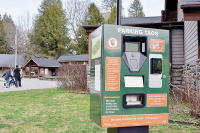The Naturalist's Corner
New neighbors
I have always had a good number of neotropical migrants nest every season in the woods around my home. The mornings and evenings are filled with the flute-like melodies of wood thrushes, various selections from the wide-ranging repertoire of the hooded warbler, the constant back and forth chatter of red-eyed vireos, the buzzy robin-like song and rolling “chick-buurrr” of the scarlet tanager and the more musical robin-like renditions of the rose-breasted grosbeak.
New songsters have joined the chorus this year. The dapper black-throated blue warbler with its blue-gray back, black face and flanks, clear white underside and white kerchief on the wings is one of the new choristers. I have, occasionally, heard black-throated blues from rather deep in the woods in the past. But this year the noisy crooner is right in front of the house. His buzzy “I’m so lazyeeee” plus longer and shorter derivatives are loud and conspicuous.
The northern parula — another wood warbler of the family Parulidae — is also a new nester at my home this year. The male northern parula is quite a colorful little bird. The parula is grayish above and if you’re fortunate enough to catch one foraging low enough you can see a greenish-orange iridescent patch on its back. He has whitish spectacles and two white wing bars. The throat is yellow and the yellow extends to the chest. It is broken by a dark bar across the throat that has an orange wash (similar to the color on its back) below it.
The northern parula’s standard song is a buzzy, ascending trill that breaks off abruptly at the end. Alternate songs include short buzzy notes, generally with a trill at the end. Some of the parula’s and black-throated blue’s alternate songs can resemble one another.
The ovenbird is another warbler that I usually hear (it has a very loud song) from the woods that has moved in next door this year. In fact, I have often seen the ground-dwelling ovenbird just outside the window from my computer desk. The rusty-backed ovenbird with its darkly streaked breast is suggestive of a thrush but it is sparrow-sized and it has an orange crown.
Related Items
Many field guides describe the ovenbird’s song as a loud, emphatic “teacher, teacher, teacher.” But in this region the song is monosyllabic, “teach, teach, teach.”
My other new neighbor this year is not a warbler but a flycatcher. The Acadian flycatcher is one of a group of five small flycatchers of the genus Empidonax. All of these dusky little (five inches or so) flycatchers have wing bars and eye-rings and are best identified in the field by voice. The Acadian is the delivery boy of the group, its enthusiastic shout of “pizza” ringing out from the woods.
I don’t know what, if anything, this year’s new suite of nesters says about the environment around my home. Is the maturing forest more attractive to these species? Are these species becoming more numerous and/or expanding their ranges or is it simply the luck of the draw?
Whatever the reason, I’m happy to have these new neighbors and hope that next year will be a replay.









